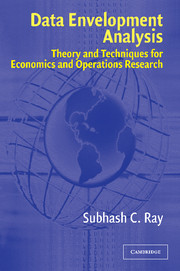Book contents
- Frontmatter
- Contents
- Preface
- 1 Introduction and Overview
- 2 Productivity Efficiency, and Data Envelopment Analysis
- 3 Variable Returns to Scale: Separating Technical and Scale Efficiencies
- 4 Extensions to the Basic DEA Models
- 5 Nonradial Models and Pareto–Koopmans Measures of Technical Efficiency
- 6 Efficiency Measurement without Convexity Assumption: Free Disposal Hull Analysis
- 7 Dealing with Slacks: Assurance Region/Cone Ratio Analysis, Weak Disposability, and Congestion
- 8 Efficiency of Merger and Breakup of Firms
- 9 Efficiency Analysis with Market Prices
- 10 Nonparametric Approaches in Production Economics
- 11 Measuring Total Productivity Change over Time
- 12 Stochastic Approaches to Data Envelopment Analysis
- 13 Looking Ahead
- References
- Index
2 - Productivity Efficiency, and Data Envelopment Analysis
Published online by Cambridge University Press: 24 November 2009
- Frontmatter
- Contents
- Preface
- 1 Introduction and Overview
- 2 Productivity Efficiency, and Data Envelopment Analysis
- 3 Variable Returns to Scale: Separating Technical and Scale Efficiencies
- 4 Extensions to the Basic DEA Models
- 5 Nonradial Models and Pareto–Koopmans Measures of Technical Efficiency
- 6 Efficiency Measurement without Convexity Assumption: Free Disposal Hull Analysis
- 7 Dealing with Slacks: Assurance Region/Cone Ratio Analysis, Weak Disposability, and Congestion
- 8 Efficiency of Merger and Breakup of Firms
- 9 Efficiency Analysis with Market Prices
- 10 Nonparametric Approaches in Production Economics
- 11 Measuring Total Productivity Change over Time
- 12 Stochastic Approaches to Data Envelopment Analysis
- 13 Looking Ahead
- References
- Index
Summary
Introduction
Any decision-making problem faced by an economic agent (such as a consumer or a producer) has three basic features. First, there are the variables whose values are chosen by the agent. These are the choice or decision variables in the problem. Second, there are the restrictions that define the set of feasible values from which to choose. Finally, there is some criterion function that assigns different values to the outcomes from alternative decisions.
In the context of production, the decision-making agent is the firm. The choice variables are the quantities of outputs to be produced as well as the quantities of inputs used. The input–output combination selected by the firm must be technically feasible in the sense that it must be possible to produce the output bundle selected from the associated input bundle. For a commercial firm facing well-defined market prices of inputs and outputs, the profit measured by the difference between revenue and cost serves as the criterion of choice. It is possible, therefore, to rank the alternative feasible input–output combinations in order of the profit that results from them.
When the criterion function has a finite maximum value attainable over the feasible set of the choice variables, this maximum value can be used as a benchmark for evaluating the efficiency of a decision-making agent. The closer the actual profit of a firm is to the maximum attainable, the greater is its efficiency.
- Type
- Chapter
- Information
- Data Envelopment AnalysisTheory and Techniques for Economics and Operations Research, pp. 12 - 45Publisher: Cambridge University PressPrint publication year: 2004



